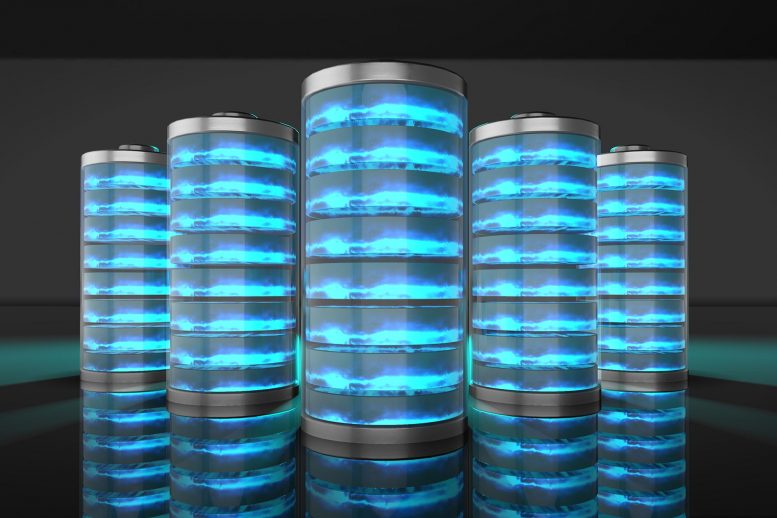
ETH Zurich has developed a method that dramatically cuts down on fluorine use in lithium metal batteries, doubling energy storage capacity while enhancing safety and environmental friendliness.
Lithium metal batteries stand out as a leading contender for the next wave of advanced, high-energy batteries. They offer at least double the energy storage per unit volume compared to the commonly used lithium-ion batteries. As a result, this advancement could allow an electric vehicle to cover double the distance on a single charge or enable a smartphone to require less frequent recharging.
At present, there is still one crucial drawback with lithium metal batteries: the liquid electrolyte requires the addition of significant amounts of fluorinated solvents and fluorinated salts, which increases its environmental footprint. Without the addition of fluorine, however, lithium metal batteries would be unstable, they would stop working after very few charging cycles and be prone to short circuits as well as overheating and igniting. A research group led by Maria Lukatskaya, Professor of Electrochemical Energy Systems at ETH Zurich, has now developed a new method that dramatically reduces the amount of fluorine required in lithium metal batteries, thereby rendering them more environmentally friendly and more stable as well as cost-effective.
A stable protective layer increases battery safety and efficiency
The fluorinated compounds from electrolytes help the formation of a protective layer around the metallic lithium at the negative electrode of the battery. “This protective layer can be compared to the enamel of a tooth,” Lukatskaya explains. “It protects the metallic lithium from continuous reaction with electrolyte components.” Without it, the electrolyte would quickly get depleted during cycling, the cell would fail, and the lack of a stable layer would result in the formation of lithium metal whiskers – ‘dendrites’ – during the recharging process instead of a conformal flat layer.
Should these dendrites touch the positive electrode, this would cause a short circuit with the risk that the battery heats up so much that it ignites. The ability to control the properties of this protective layer is therefore crucial for battery performance. A stable protective layer increases battery efficiency, safety, and service life.
Minimizing fluorine content
“The question was how to reduce the amount of added fluorine without compromising the protective layer’s stability,” says doctoral student Nathan Hong. The group’s new method uses electrostatic attraction to achieve the desired reaction. Here, electrically charged fluorinated molecules serve as a vehicle to transport the fluorine to the protective layer. This means that only 0.1 percent by weight of fluorine is required in the liquid electrolyte, which is at least 20 times lower than in prior studies.
The optimized method makes batteries greener
The ETH Zurich research group describes the new method and its underlying principles in a paper recently published in the journal Energy & Environmental Science. An application for a patent has been made.
One of the biggest challenges was to find the right molecule to which fluorine could be attached and that would also decompose again under the right conditions once it had reached the lithium metal. As the group explains, a key advantage of this method is that it can be seamlessly integrated into the existing battery production process without generating additional costs to change the production setup. The batteries used in the lab were the size of a coin. In a next step, the researchers plan to test the method’s scalability and apply it to pouch cells as used in smartphones.
Reference: “Robust battery interphases from dilute fluorinated cations” by Chulgi Nathan Hong, Mengwen Yan, Oleg Borodin, Travis P. Pollard, Langyuan Wu, Manuel Reiter, Dario Gomez Vazquez, Katharina Trapp, Ji Mun Yoo, Netanel Shpigel, Jeremy I. Feldblyum and Maria R. Lukatskaya, 2 May 2024, Energy & Environmental Science.
DOI: 10.1039/D4EE00296B
3 Comments
I liked the fact that such batteries are able not only to have two times more charge, but also to preserve the environment. But how complicated is its creation method? Will it be possible to make it in industrial quantities? That’s what everyone is interested in
Probably a more important question is about the economics. EVs are already painfully expensive, with poor re-sale value. If these batteries are significantly more expensive than conventional Li-ion batteries, and nobody buys the cars, only NASA will use them. Their advantages will be moot if no one can afford them. Producing metallic lithium requires more energy than just purifying lithium salts. Will that create more CO2 and defeat the purpose?
Promises, promises. Even if this particular promise somehow saw the market, which it won’t, it would still do precisely zero to save the environment. You would still need insane amounts of water and sulphuric acid to process just one ton of lithium ore. In what universe is water depletion and contaminating ground with acid good for the environment?